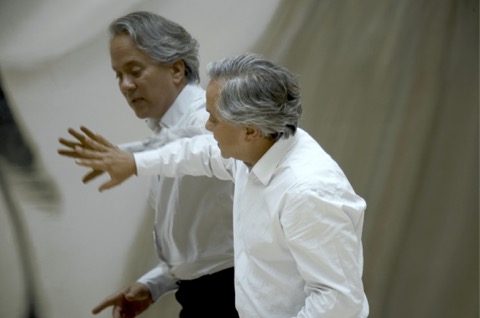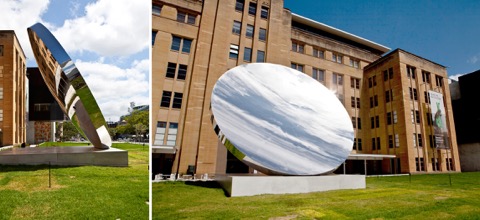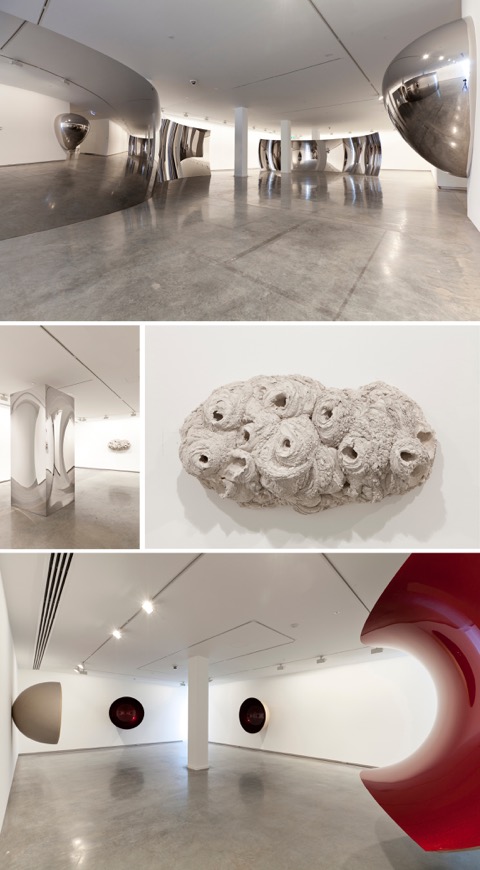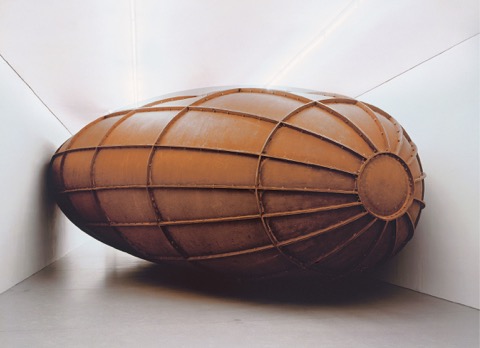
MCA: Anish Kapoor
At Australia’s MCA, an exhibition by famous contemporary British sculptor Anish Kapoor is a tour de force, writes Susie Burge


There’s largeness about Anish Kapoor, in every way. His voice is resonant and modulated, with the eloquence of a Shakespearean actor; his presence is charismatic (he’s not a tall man, yet there’s a compelling aura); and of course there’s his work. In 2011 Kapoor installed “Leviathan” in the Grand Palais in Paris. Part of the annual Monumenta series (following on from Anselm Keifer and Christian Boltanski), Leviathan, strikingly, architecturally and quite beautifully, took up the entire gi-normous space, as if the building itself were pregnant, and created a new transitory environment. In 2012, his mad tower - Orbit - was the headline art exhibit and viewing platform for the London Olympics. Now, in Sydney, he addresses the contentious issue of public sculpture (he’s on record as saying he thinks it should be more than a bit of decoration on the lawn) by waving a hand to the surrounds, the Opera House and the Harbour Bridge, both visible from the museum, as effective (architectural) examples of public sculpture. Kapoor is a believer in scale. Placed just outside the Museum of Contemporary Art, his own Sky Mirror joins the conversation.Above: Anish Kapoor 2007. Image courtesy and © the artist. Photograph: Phillipe Chancel

Above: Anish Kapoor - Sky Mirror 2006 - MCA installation view 2012-13 stainless steel. Courtesy and © the artist. Photograph: Alex Davies
Sky Mirror is a monumental concave/convex disc of polished stainless steel, reflecting on one side the endlessly changeable sky and clouds and on the other the historic sandstone façade of the museum itself and you/me/the viewer, tiny, looking up. The sculpture was first conceived for and installed in the Rockefeller Center in New York City post 9/11. It had a more poignant, pointed meaning then, mirroring the sky on one side and conversely, bringing the sky to earth.
Kapoor is interested in illusion and reflection. His colossal Cloudgate in Chicago (a mirror-finish stainless steel sculpture based on a supersized drop of mercury and nicknamed “The Bean”) has become an icon of the city, endlessly visited and photographed by locals and tourists alike, arguably the most famous contemporary public artwork in the US today. Yet even when Kapoor is working to a more modest template, his sculptures command an impressive volume of space.
The mirrored works in the first gallery of Kapoor’s MCA show are crowd pleasers (enter audience mugging for the camera, seeing their faces and bodies reflected and distorted, their ant-like or sylph-like or elephant-like multiple selves). I appreciated the sculptures for the fun & tricky cleverness, but I loved them more when the room was almost empty, when the mirror was clearest and more akin to a silvery slice of nothingness rising up from the white floor, or set deceptively, confusingly into a white wall or segmented like the eye of a bee.

Above: Anish Kapoor MCA installation views, 2012. Images courtesy and © the artist. Photograph: Alex Davies
Where the mirrors are almost non-objects, or echoes of objects (or narcissistic repetitions of the self, always elusive, always distorted, always somehow lost in space) the pigment works are space or nothingness made solid and given a colour. Wall sculptures, like big beautiful mixing bowls of lolly pink and blood red and deep magenta turned on their side, seem to cup and hold a section or area of space. They are simple and powerful with a nod to sixties minimalism. Then, there are the mysterious voids.
I’m not alone in thinking the voids are Anish Kapoor’s masterworks. These pigment sculptures may seem at first flat (like paintings, with an illusion of depth) and then subtly will reveal a mysterious void, a sucking inwards, a – possibly infinite? – inward drawing force, the yin to the yang of the vibrant colour. Like Barnett Newman, Mark Rothko, Lucio Fontana, there is an emotive field, a link to the mystical and sexual, the spiritual or sublime. (The endless creative potential of the void.) Sometimes, Kapoor’s wall sculptures seem like Brancusi forms turned inside out. His work also connects with his Indian heritage (that extraordinarily vivid pigment) and with tribal art (the sacred waterhole, for instance) and with the wondrous contemporary scientific exploration of the universe – black holes, anti-matter, warps of space/time.
My favourite work in the show, Memory 2008, was originally commissioned for the Deutsche Guggenheim. It comes in 2 parts. The first, hidden around a corner, appears as a dark rectangular shape on the wall, a void. There’s space beyond, dim, mineral and cool. The air smells of iron and by association, blood. Sticking my head inside (well, no one told me not to) my face is enveloped by mysterious humid darkness that lightens imperceptibly as I strain my eyes to see. Soon, it becomes apparent that I’m looking into a vast curved womb-like construction made of rusted steel. It recedes into pitch, twilight or dawn glimmering at the edges, the smell of rust and metal sparking a symbiotic taste in my mouth. I want to climb inside and explore. What is it – a primal cave, a Serra-like chamber, a Proustian curve of regret?

Memory 2008 - MCA installation view 2012-13, Cor-Ten steel. Deutsche Bank and Solomon R. Guggenheim Foundation. Image courtesy and © the artist. Photograph: Alex Davies
On the flip side … walking all the way round to the end of the galleries … Memory is revealed as an enormous elliptical pod made of sections of rusted cor-ten steel bolted together. It’s so big it seems squeezed into the gallery, as if it barely fits … growing like a seed pod and about to bust out like a Triffid, or enclosed and confined like a mid 20th century blimp or imaginary alien spaceship. Whatever, it’s bloody big. And it’s seductive close up, the chalky rusted tones and fragile surface texture.
“Art is good at something called intimacy,” said Kapoor at the Sydney preview. “It’s good at saying come over here, come and be part of this.” And then, talking about his own practice: “It is about a very specific address to your body and therefore to your mind – it demands a personal engagement, it’s what we all want and need.”
On the way out, walking back through the galleries past huge chunks of marble, strange concrete, impossibly rich sly sensual vortexes of powdery pigment, I stop at the mouth of Memory again. I have a moment alone before the approach of another. Instead of standing humbly, politely peering in like me, the guy claps. The chamber reverberates like a broken heart. “I saw Leviathan in Paris,” he says, clapping again. I join in. “Everyone started to clap, there were hundreds of people clapping. It was profoundly moving,” he offers, “It was extraordinary.”
Anish Kapoor is on at the MCA till April 1, 2013 www.mca.com.au
Words - Susie Burge, all rights reserved. Images courtesy the artist and the Museum of Contemporary Art, Sydney. If sharing this article please credit Artravelife.com and Susie Burge.